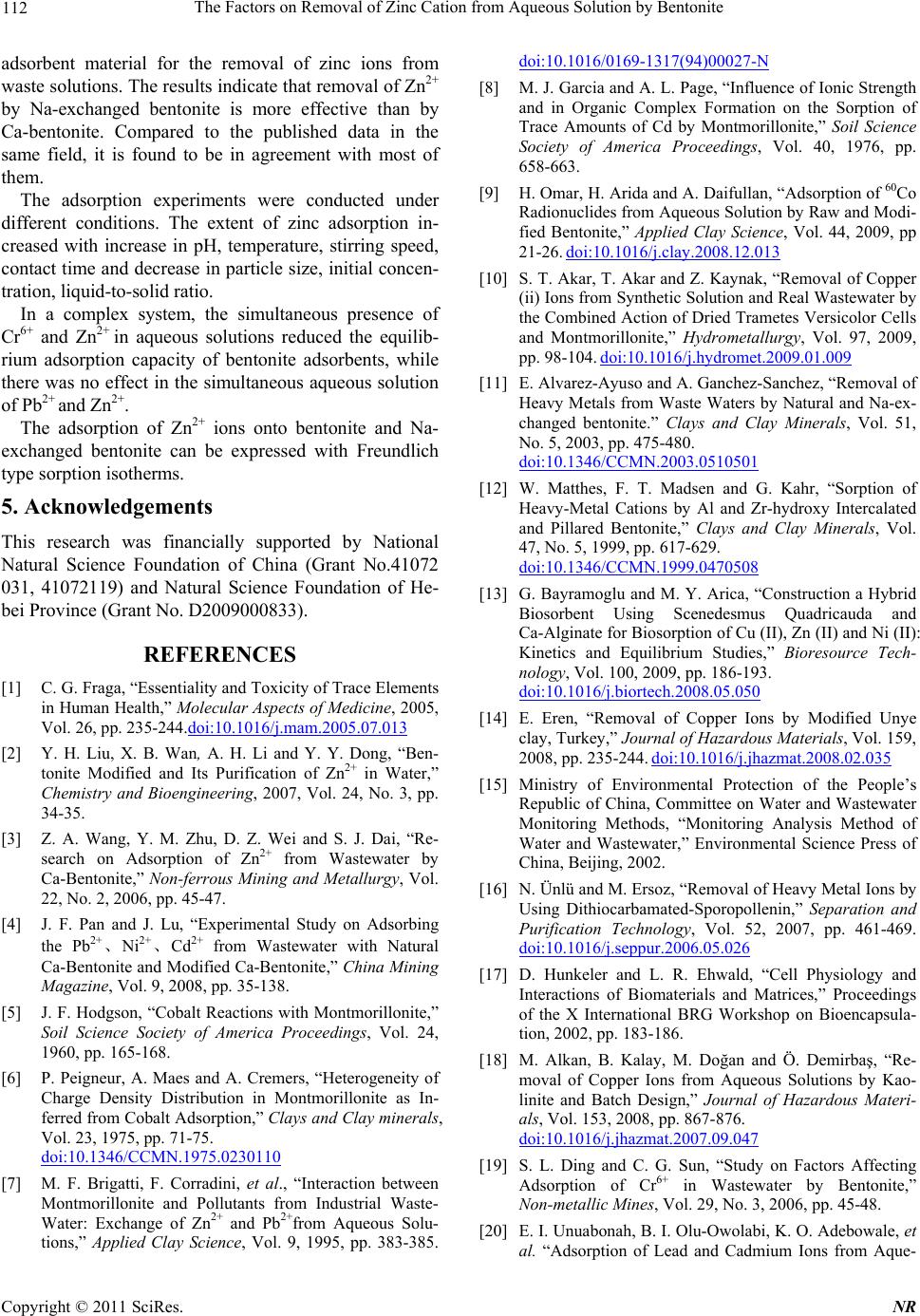
112 The Factors on Removal of Zinc Cation from Aqueous Solution by Bentonite
adsorbent material for the removal of zinc ions from
waste solutions. The results indicate that removal of Zn2+
by Na-exchanged bentonite is more effective than by
Ca-bentonite. Compared to the published data in the
same field, it is found to be in agreement with most of
them.
The adsorption experiments were conducted under
different conditions. The extent of zinc adsorption in-
creased with increase in pH, temperature, stirring speed,
contact time and decrease in particle size, initial concen-
tration, liquid-to-solid ratio.
In a complex system, the simultaneous presence of
Cr6+ and Zn2+ in aqueous solutions reduced the equilib-
rium adsorption capacity of bentonite adsorbents, while
there was no effect in the simultaneous aqueous solution
of Pb2+ and Zn2+.
The adsorption of Zn2+ ions onto bentonite and Na-
exchanged bentonite can be expressed with Freundlich
type sorption isotherms.
5. Acknowledgements
This research was financially supported by National
Natural Science Foundation of China (Grant No.41072
031, 41072119) and Natural Science Foundation of He-
bei Province (Grant No. D2009000833).
REFERENCES
[1] C. G. Fraga, “Essentiality and Toxicity of Trace Elements
in Human Health,” Molecular Aspects of Medicine, 2005,
Vol. 26, pp. 235-244.doi:10.1016/j.mam.2005.07.013
[2] Y. H. Liu, X. B. Wan, A. H. Li and Y. Y. Dong, “Ben-
tonite Modified and Its Purification of Zn2+ in Water,”
Chemistry and Bioengineering, 2007, Vol. 24, No. 3, pp.
34-35.
[3] Z. A. Wang, Y. M. Zhu, D. Z. Wei and S. J. Dai, “Re-
search on Adsorption of Zn2+ from Wastewater by
Ca-Bentonite,” Non-ferrous Mining and Metallurgy, Vol.
22, No. 2, 2006, pp. 45-47.
[4] J. F. Pan and J. Lu, “Experimental Study on Adsorbing
the Pb2+、Ni2+、Cd2+ from Wastewater with Natural
Ca-Bentonite and Modified Ca-Bentonite,” China Mining
Magazine, Vol. 9, 2008, pp. 35-138.
[5] J. F. Hodgson, “Cobalt Reactions with Montmorillonite,”
Soil Science Society of America Proceedings, Vol. 24,
1960, pp. 165-168.
[6] P. Peigneur, A. Maes and A. Cremers, “Heterogeneity of
Charge Density Distribution in Montmorillonite as In-
ferred from Cobalt Adsorption,” Clays and Clay minerals,
Vol. 23, 1975, pp. 71-75.
doi:10.1346/CCMN.1975.0230110
[7] M. F. Brigatti, F. Corradini, et al., “Interaction between
Montmorillonite and Pollutants from Industrial Waste-
Water: Exchange of Zn2+ and Pb2+from Aqueous Solu-
tions,” Applied Clay Science, Vol. 9, 1995, pp. 383-385.
doi:10.1016/0169-1317(94)00027-N
[8] M. J. Garcia and A. L. Page, “Influence of Ionic Strength
and in Organic Complex Formation on the Sorption of
Trace Amounts of Cd by Montmorillonite,” Soil Science
Society of America Proceedings, Vol. 40, 1976, pp.
658-663.
[9] H. Omar, H. Arida and A. Daifullan, “Adsorption of 60Co
Radionuclides from Aqueous Solution by Raw and Modi-
fied Bentonite,” Applied Clay Science, Vol. 44, 2009, pp
21-26. doi:10.1016/j.clay.2008.12.013
[10] S. T. Akar, T. Akar and Z. Kaynak, “Removal of Copper
(ii) Ions from Synthetic Solution and Real Wastewater by
the Combined Action of Dried Trametes Versicolor Cells
and Montmorillonite,” Hydrometallurgy, Vol. 97, 2009,
pp. 98-104. doi:10.1016/j.hydromet.2009.01.009
[11] E. Alvarez-Ayuso and A. Ganchez-Sanchez, “Removal of
Heavy Metals from Waste Waters by Natural and Na-ex-
changed bentonite.” Clays and Clay Minerals, Vol. 51,
No. 5, 2003, pp. 475-480.
doi:10.1346/CCMN.2003.0510501
[12] W. Matthes, F. T. Madsen and G. Kahr, “Sorption of
Heavy-Metal Cations by Al and Zr-hydroxy Intercalated
and Pillared Bentonite,” Clays and Clay Minerals, Vol.
47, No. 5, 1999, pp. 617-629.
doi:10.1346/CCMN.1999.0470508
[13] G. Bayramoglu and M. Y. Arica, “Construction a Hybrid
Biosorbent Using Scenedesmus Quadricauda and
Ca-Alginate for Biosorption of Cu (II), Zn (II) and Ni (II):
Kinetics and Equilibrium Studies,” Bioresource Tech-
nology, Vol. 100, 2009, pp. 186-193.
doi:10.1016/j.biortech.2008.05.050
[14] E. Eren, “Removal of Copper Ions by Modified Unye
clay, Turkey,” Journal of Hazardous Materials, Vol. 159,
2008, pp. 235-244. doi:10.1016/j.jhazmat.2008.02.035
[15] Ministry of Environmental Protection of the People’s
Republic of China, Committee on Water and Wastewater
Monitoring Methods, “Monitoring Analysis Method of
Water and Wastewater,” Environmental Science Press of
China, Beijing, 2002.
[16] N. Ünlü and M. Ersoz, “Removal of Heavy Metal Ions by
Using Dithiocarbamated-Sporopollenin,” Separation and
Purification Technology, Vol. 52, 2007, pp. 461-469.
doi:10.1016/j.seppur.2006.05.026
[17] D. Hunkeler and L. R. Ehwald, “Cell Physiology and
Interactions of Biomaterials and Matrices,” Proceedings
of the X International BRG Workshop on Bioencapsula-
tion, 2002, pp. 183-186.
[18] M. Alkan, B. Kalay, M. Doğan and Ö. Demirbaş, “Re-
moval of Copper Ions from Aqueous Solutions by Kao-
linite and Batch Design,” Journal of Hazardous Materi-
als, Vol. 153, 2008, pp. 867-876.
doi:10.1016/j.jhazmat.2007.09.047
[19] S. L. Ding and C. G. Sun, “Study on Factors Affecting
Adsorption of Cr6+ in Wastewater by Bentonite,”
Non-metallic Mines, Vol. 29, No. 3, 2006, pp. 45-48.
[20] E. I. Unuabonah, B. I. Olu-Owolabi, K. O. Adebowale, et
al. “Adsorption of Lead and Cadmium Ions from Aque-
C
opyright © 2011 SciRes. NR